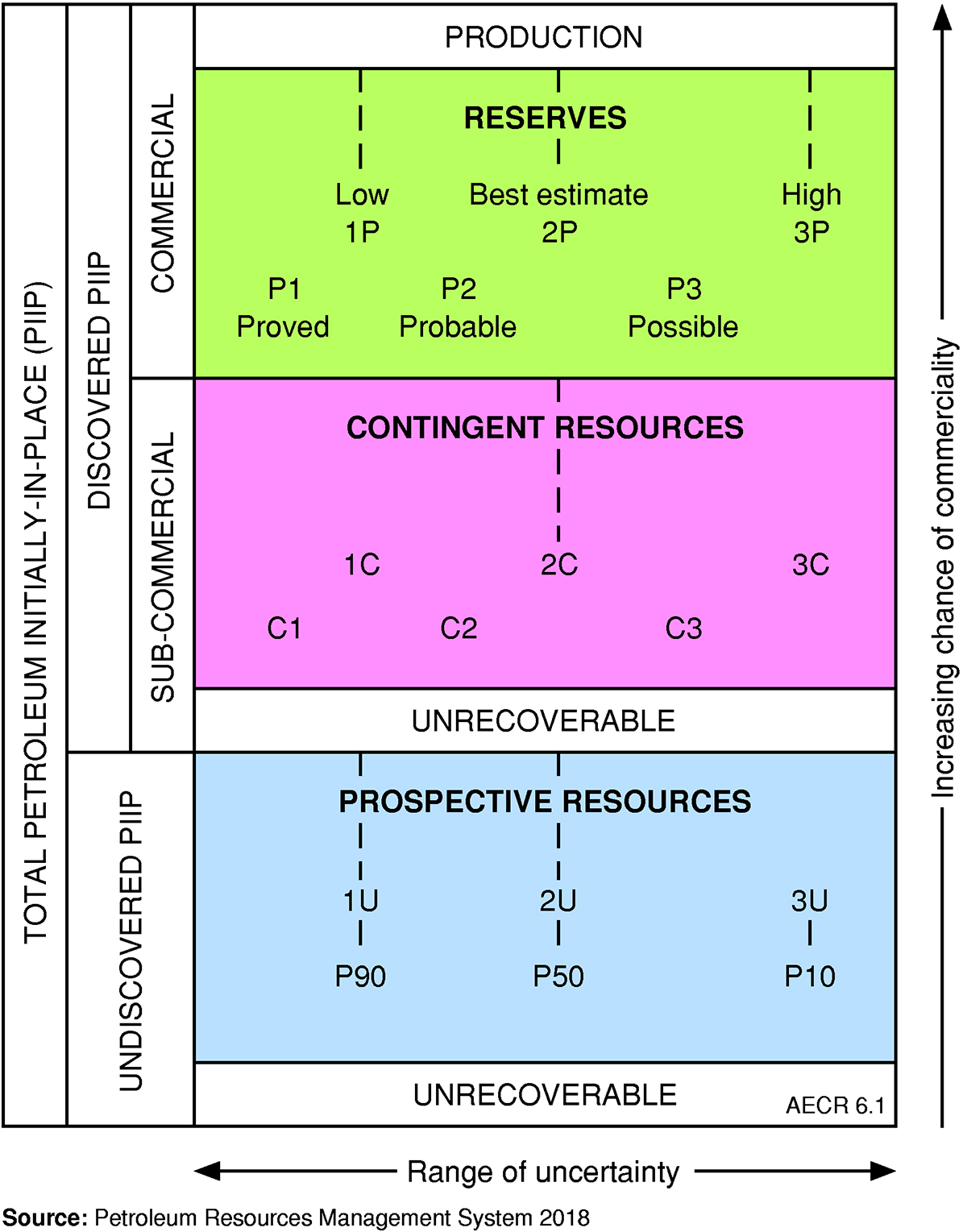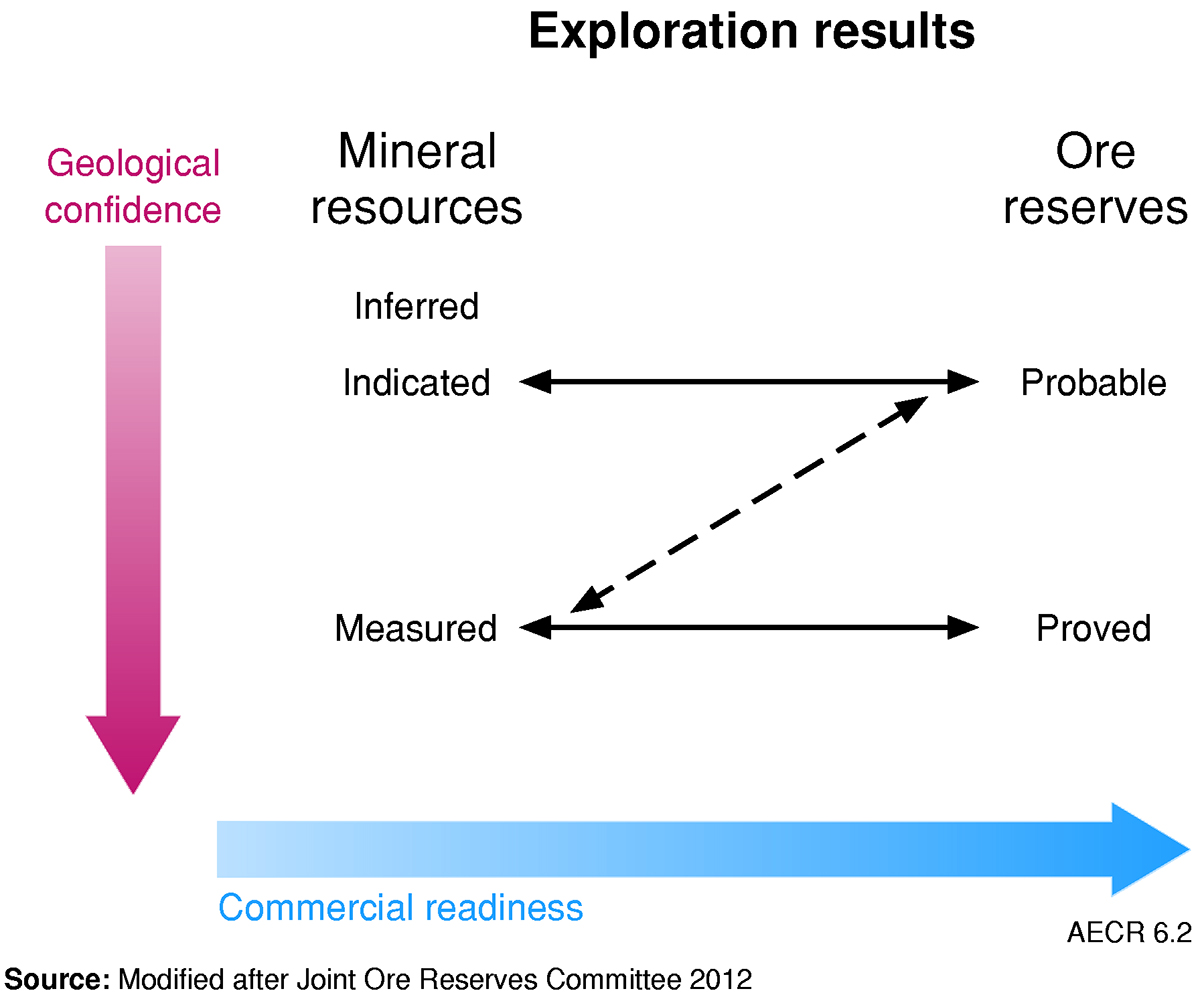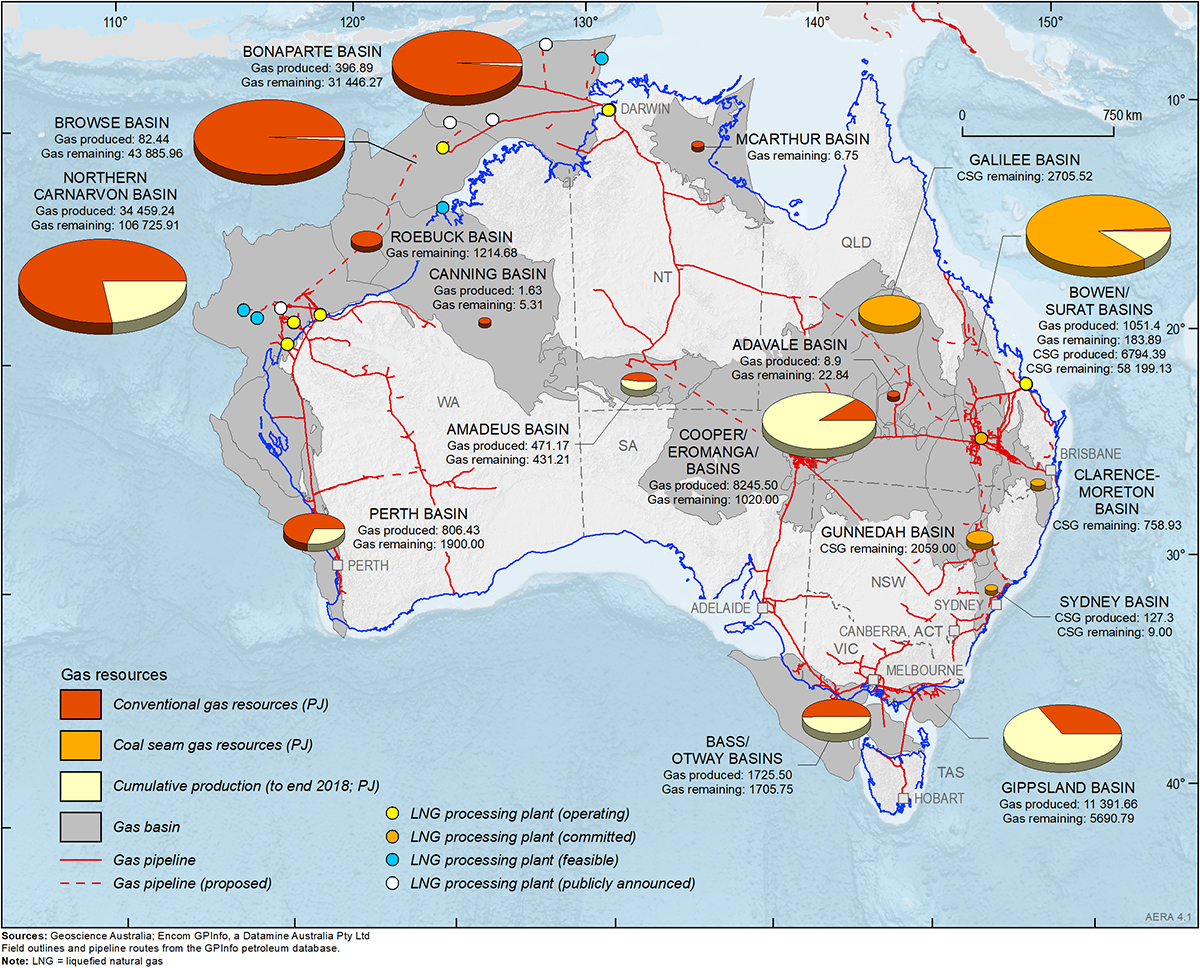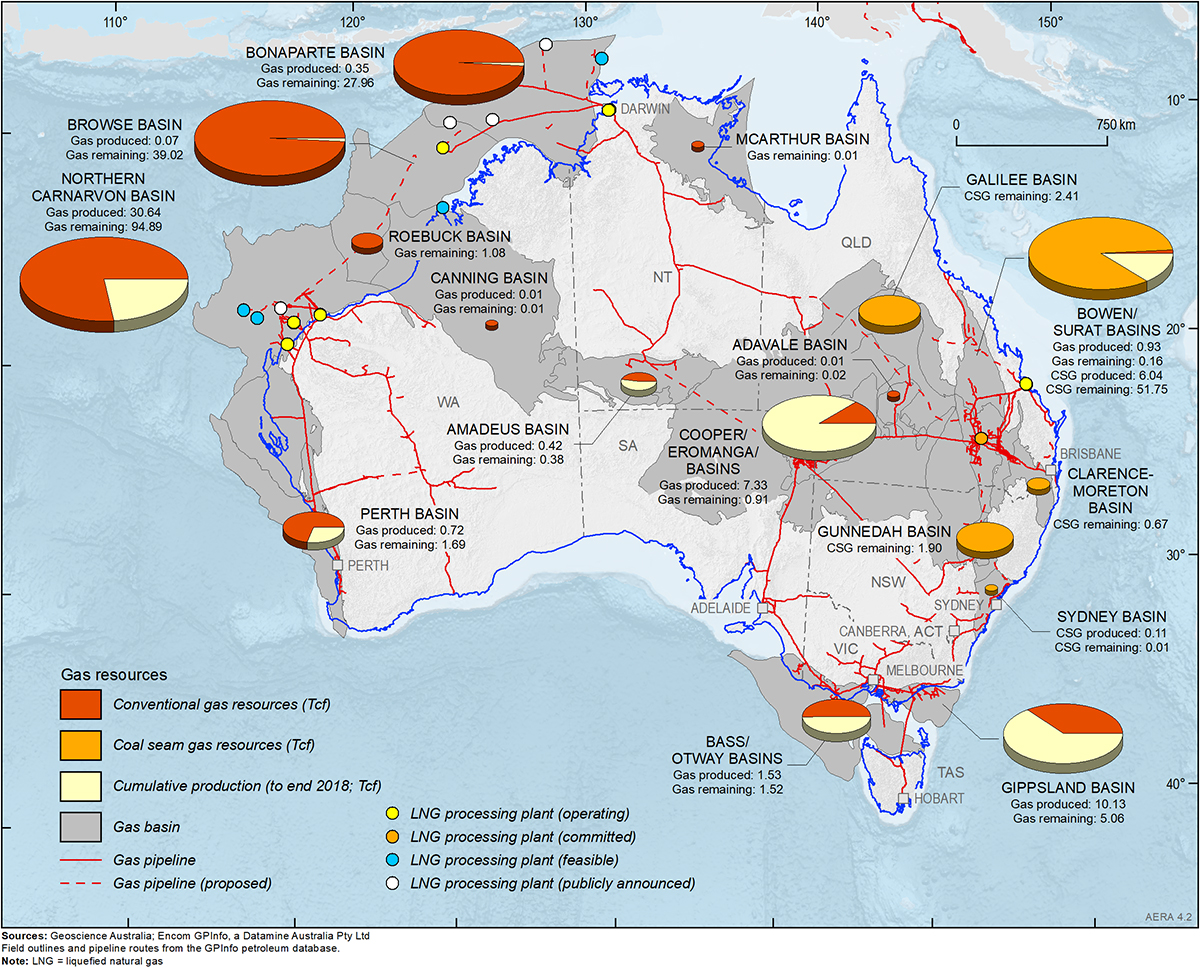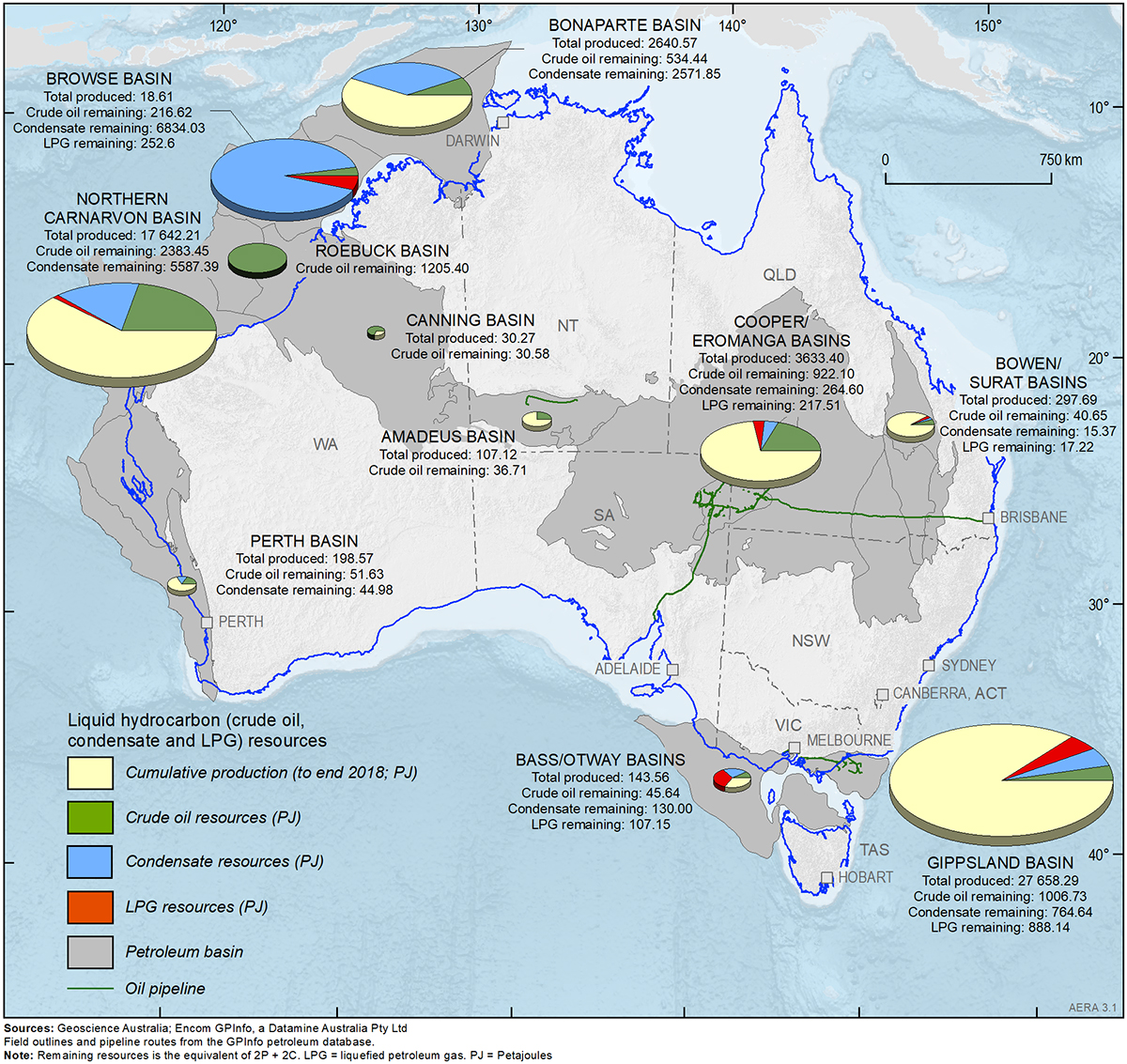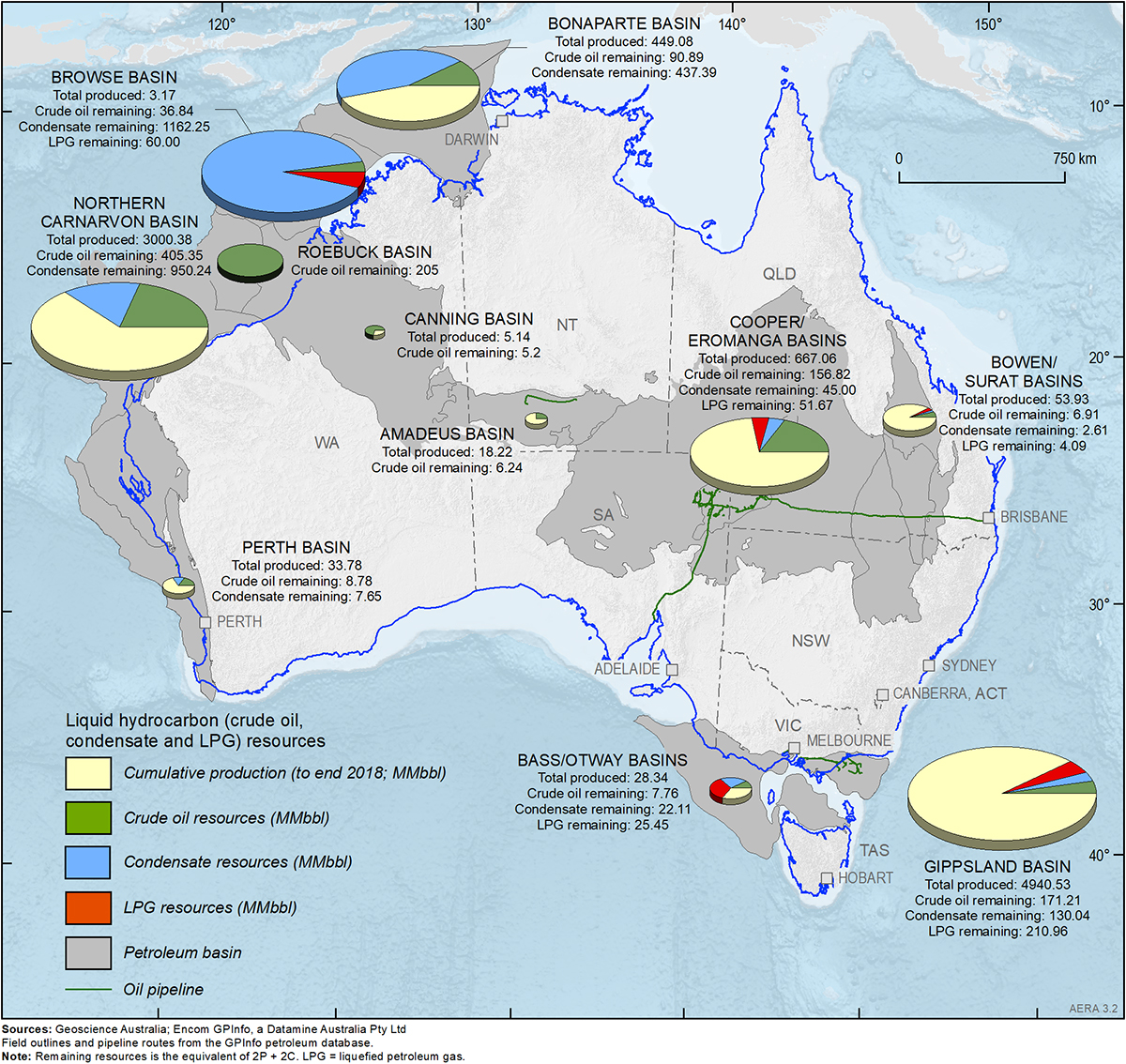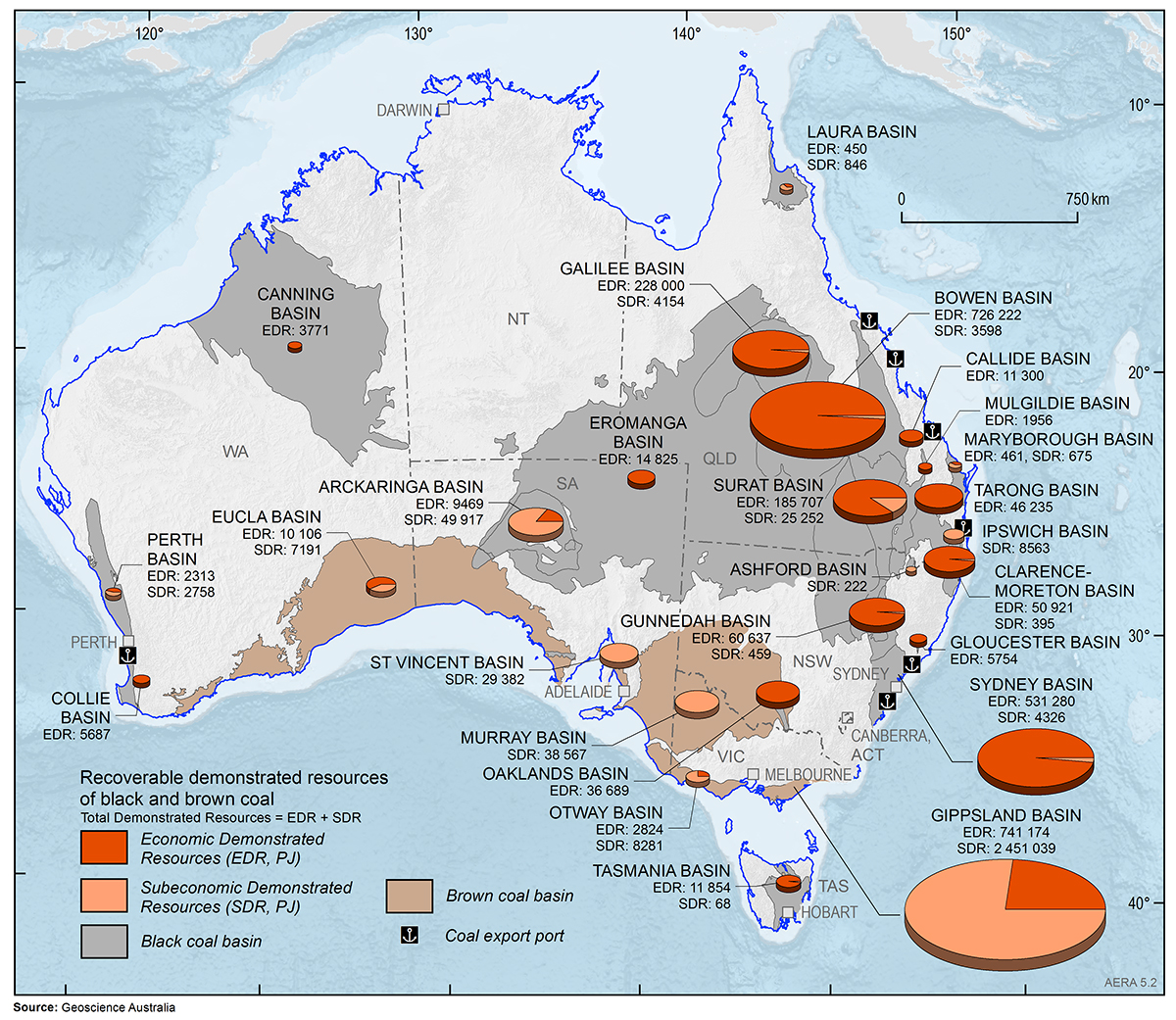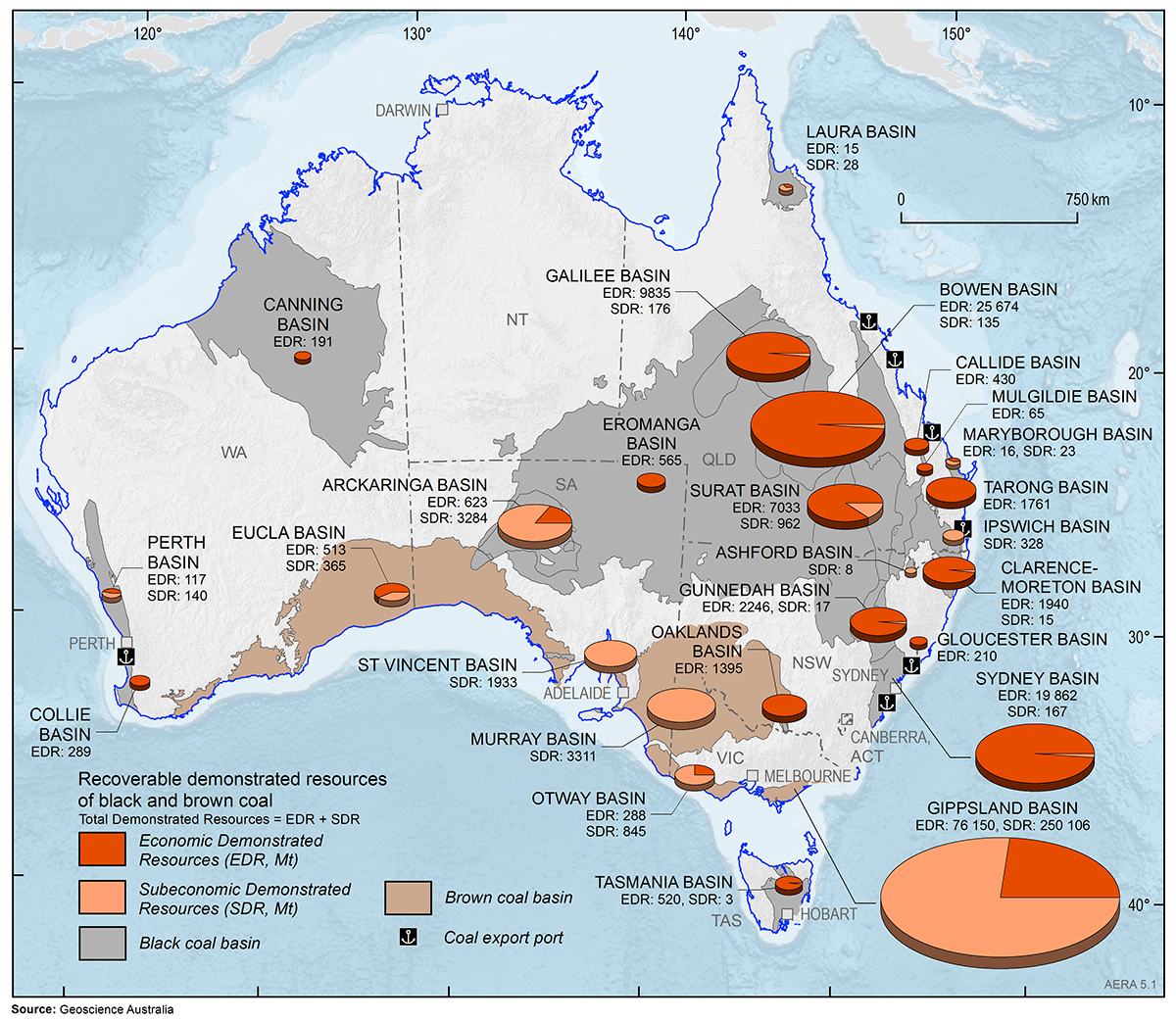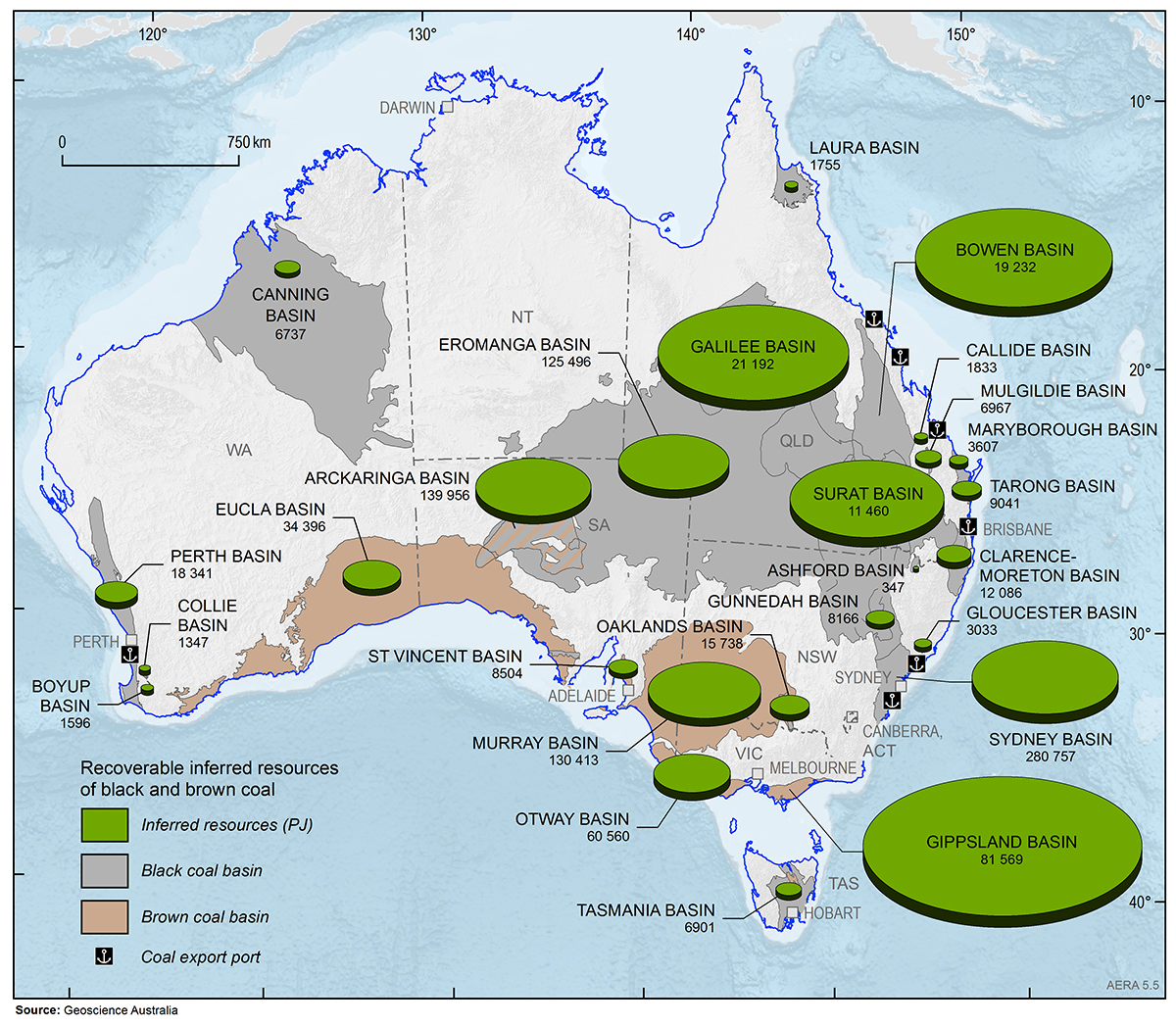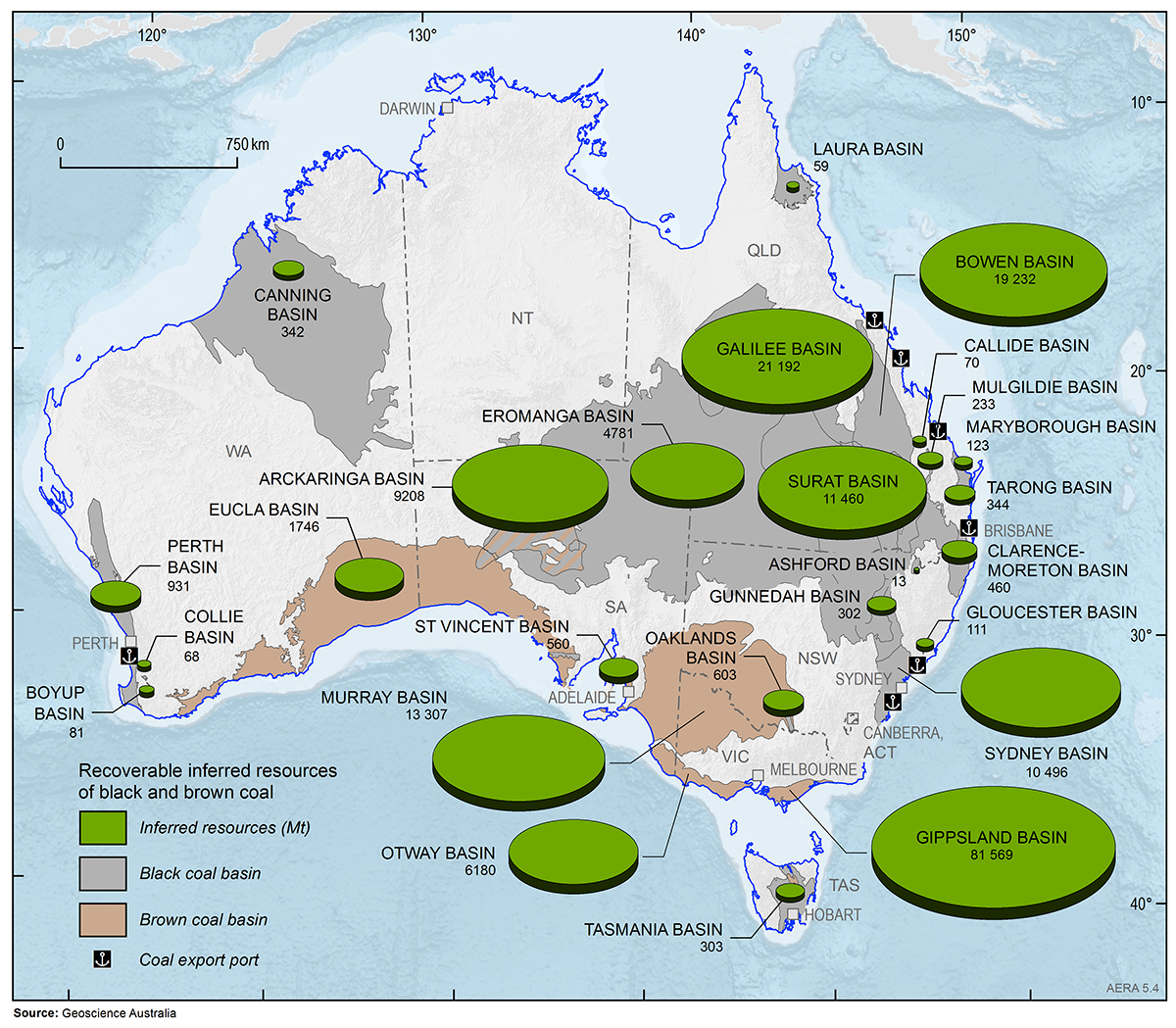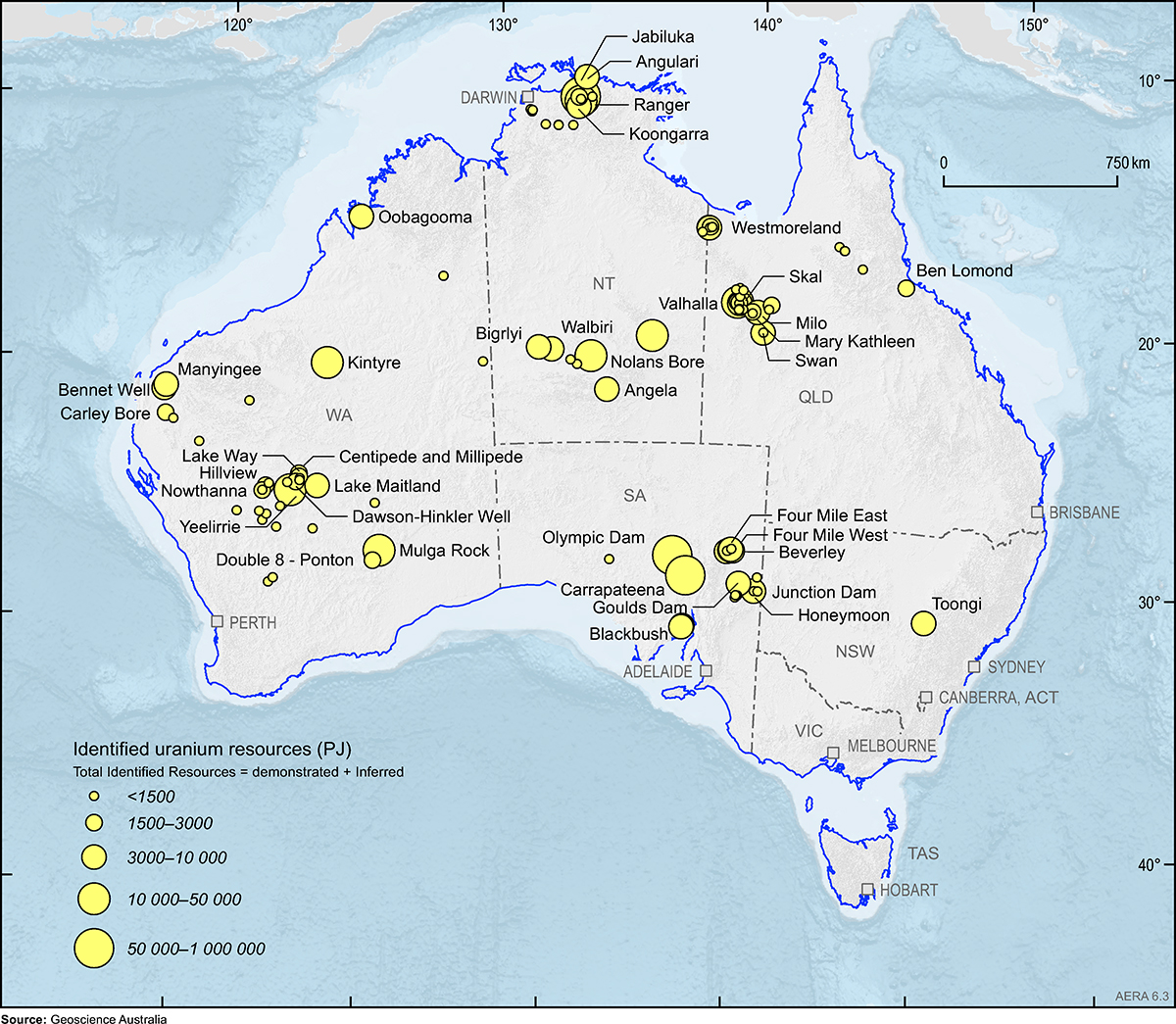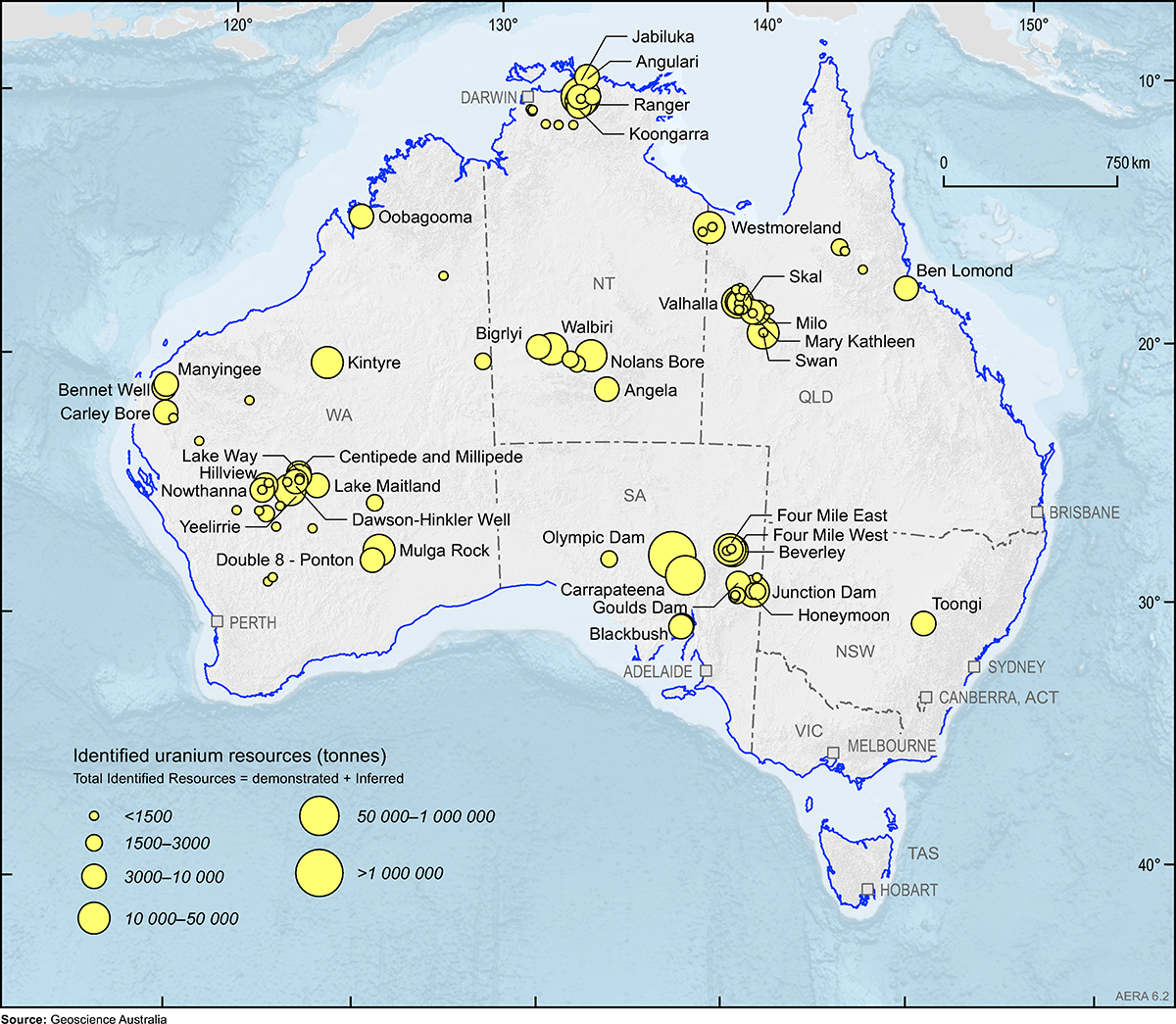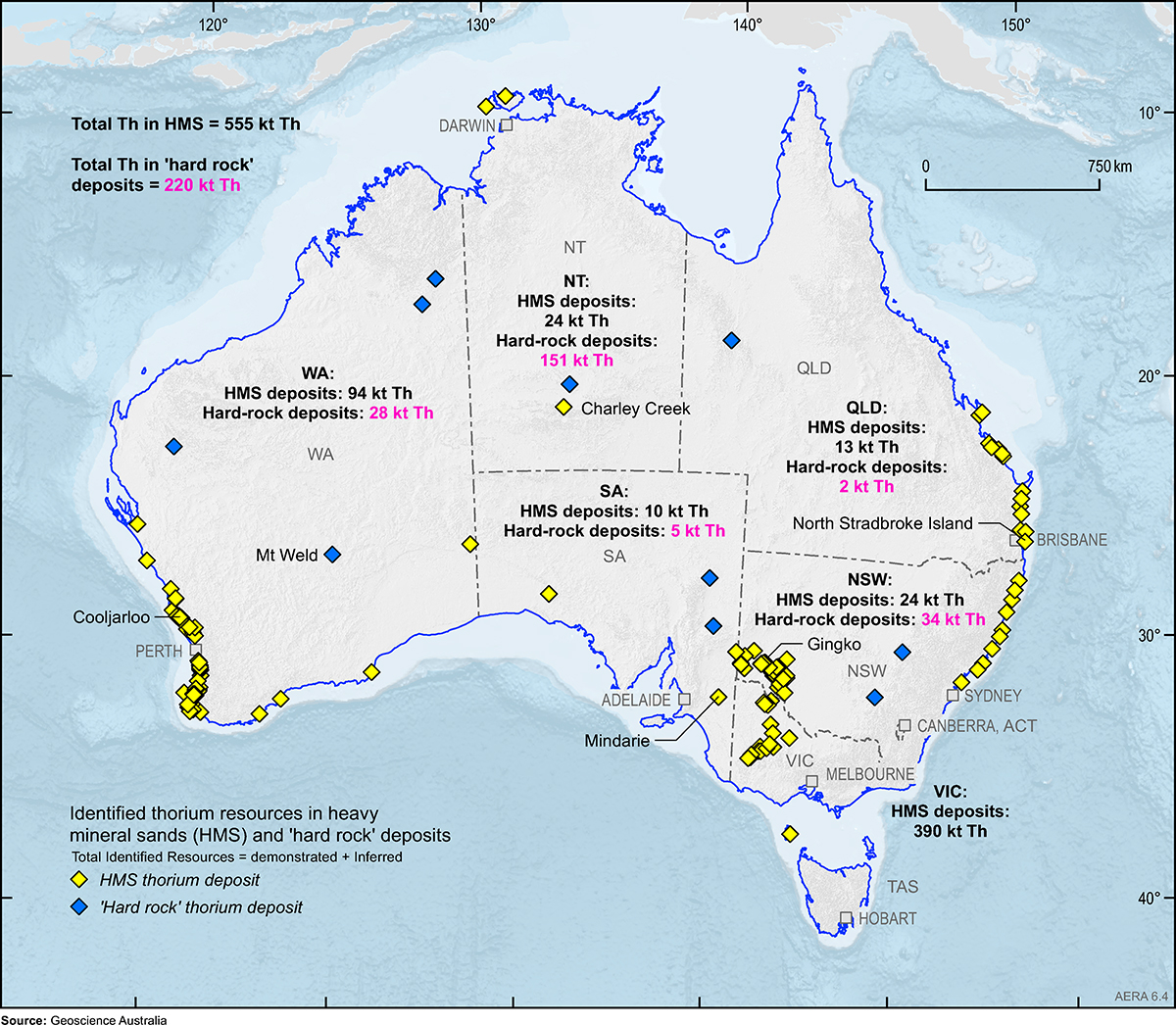Appendix 1: Glossary
Accumulation (petroleum)
An individual body of naturally occurring petroleum in a reservoir or a group of reservoirs that are related to a localised geological structural feature and/or stratigraphic condition (trap).
Basin
A geological depression filled with sedimentary rocks.
Basin centred gas
A type of tight gas that occurs in distributed basin centred gas accumulations, where gas is hosted in low permeability reservoirs which are commonly abnormally overpressured, lack a down dip water contact and are continuously saturated with gas.
Black coal
A coal of either sub-bituminous, bituminous or anthracite rank.
Brown coal
A coal intermediate between peat and bituminous coal; lignite.
Coal oil
The crude oil obtained by the destructive distillation of bituminous coal.
Coal recovery factor
Coal recovery factors are applied to coal resource estimates to calculate the recoverable coal resource. Coal recovery factors are dependent on mine type. A recovery factor of 90 per cent is applied to open cut coal mines, and 50–75 per cent is applied to underground coal mines.
Coal reserve
A coal Reserve is reported at a higher level of confidence than a coal Resource and includes diluting materials, and allowances for losses which may occur during mining. Geoscience Australia does not apply recovery factors to coal Reserves.
Coal seam gas (CSG)
A form of natural gas (generally 95% to 97% pure methane, CH4) contained in coal deposits and extracted from coal seams, typically at depths of 300 to 1000 m.
Completion (petroleum)
The process by which a finished well (borehole) is either sealed off or prepared for production.
Compressed natural gas (CNG)
Natural gas compressed to a pressure at or above 200-248 bar (i.e., 2900-3600 pounds per square inch) and stored in high-pressure containers. It is used as a fuel for natural gas-powered vehicles.
Condensate
A portion of natural gas of such composition that exists in the gaseous phase at the temperature and pressure of the reservoirs, but that, when produced, are in the liquid phase at surface pressure and temperature conditions.
Conventional resources (petroleum)
Petroleum resources within discrete accumulations related to localised geological structural features or stratigraphic conditions, that are recoverable through wells (boreholes) and typically require minimal processing prior to sale. For natural gas, the term generally refers to methane held in a porous rock reservoir frequently in combination with heavier hydrocarbons.
Crude oil
The portion of petroleum that exists in the liquid phase in natural underground reservoirs and remains liquid at atmospheric conditions of pressure and temperature. It does not include liquids obtained from the processing of natural gas.
Development
Petroleum: phase in which a proven oil or gas field is brought into production by drilling and completing production wells.
Minerals: phase in which the mineral deposit is brought into production through development of a mine.
Discovered accumulation (petroleum)
A petroleum accumulation where one or several exploratory wells through testing, sampling, and/or logging have demonstrated the existence of a significant quantity of potentially recoverable hydrocarbons and thus have established a known accumulation.
Discovered petroleum initially-in-place
Quantity of petroleum that is estimated, as of a given date, to be contained in known accumulations prior to production.
Discovery
Petroleum: first well (borehole) in a new field from which any measurable amount of oil or gas has been recovered. A well that makes a discovery is classified as a new field discovery (NFD).
Minerals: first drill intersection of economic grade mineralisation at a new site.
Enhanced oil recovery
The extraction of additional petroleum, beyond primary recovery, from naturally occurring reservoirs by supplementing the natural forces in the reservoir. It includes water flooding and gas injection for pressure maintenance (secondary processes) and any other means of supplementing natural reservoir recovery processes, including thermal and chemical processes to improve the in-situ mobility of viscous forms of petroleum (tertiary processes).
Exploration
Phase in which a company or organisation searches for petroleum or mineral resources by carrying out detailed geological and geophysical surveys, followed up where appropriate by drilling and other evaluation of the most prospective sites.
Extension/appraisal wells (petroleum)
Wells (boreholes) drilled to determine the physical extent, reserves and likely production rate of a field.
Feedstock
Raw material to feed an industrial process.
Field (petroleum)
An area consisting of a single reservoir or multiple reservoirs grouped on, or related to, the same individual geological structural feature and/or stratigraphic condition.
Fossil fuels
Combustible materials derived from the long-term decomposition of organic matter in geological formations. Fossil fuels include crude oil, coal and natural gas.
Gas-to-liquids
Technologies that use specialised processing (e.g. Fischer-Tropsch synthesis) to convert natural gas into liquid petroleum products.
Heavy oil
Crude oil that has a low API gravity or Baumé gravity.
Hydrocarbons
Chemical compounds consisting wholly of hydrogen and carbon molecules.
In-place (petroleum)
Petroleum-in-Place is the total quantity of petroleum that is estimated to exist originally in naturally occurring reservoirs. Oil-in-place, gas-in-place and bitumen-in-place are defined in the same manner.
In-situ gasification
A process by which a gas is made in the subsurface from coal or other solid hydrocarbons.
JORC Code
The Australasian Code for Reporting of Exploration Results, Mineral Resources and Ore Reserves, prepared by the Joint Ore Reserves Committee. It is a principles-based code which sets out recommended minimum standards and guidelines on classification and public reporting in Australasia. Companies listed on the Australian Securities Exchange are required to report exploration outcomes, resources and reserves in accordance with the JORC Code standards and guidelines.
Liquid fuels
All liquid hydrocarbons, including crude oil, condensate, liquefied petroleum gas and other refined petroleum products.
Liquefied natural gas (LNG)
Natural gas (primarily methane) that has been liquefied by reducing its temperature at atmospheric pressure.
Liquefied petroleum gas (LPG)
A group of hydrocarbon gases, primarily propane, normal butane and isobutane, derived from crude oil refining or natural gas processing. They can be liquefied through pressurization (without requiring cryogenic refrigeration) for convenience of transportation or storage. Excludes ethane and olefins.
Natural gas
The portion of petroleum that exists either in the gaseous phase or is in solution in crude oil in natural underground reservoirs, and which is gaseous at atmospheric conditions of pressure and temperature.
Natural gas liquids (NGL)
Those portions of natural gas which are recovered as liquids in separators, field facilities or gas processing plants. Natural Gas Liquids include but are not limited to ethane, propane, butanes, pentanes, and natural gasoline.
Non-renewable resources
Resources, such as fossil fuels (crude oil, natural gas, coal) and uranium that are depleted by extraction.
Oil sands
Sand and sandstone rock material which contains crude bitumen, and requires extraction using either mining and processing if near the surface, or from a well if deeply buried.
Oil shale
A kerogen-bearing finely laminated sedimentary rock that will yield hydrocarbons on distillation.
Petajoule
1015 joules, the standard form of reporting energy aggregates. One petajoule is equivalent to 278 gigawatt-hours.
Petroleum
A naturally occurring mixture consisting predominantly of hydrocarbons in the gaseous, liquid or solid phase.
Play (geological)
A model that can be used to direct petroleum exploration. It is a group of fields or prospects in the same region and controlled by the same set of geological circumstances.
Primary energy
Energy found in nature that has not been subjected to any conversion or transformation process.
Primary fuels
The forms of energy sources obtained directly from nature. They include non-renewable fuels such as black coal, brown coal, uranium, crude oil and condensate, natural gas, and renewable fuels such as biomass, hydro, wind, solar, ocean and geothermal.
Primary recovery
The extraction of petroleum from reservoirs utilising the natural energy available in the reservoirs to move fluids through the reservoir rock to points of recovery.
Production
Petroleum: the phase of bringing well fluids to the surface, separating them and storing, gauging and otherwise preparing them for transport.
Minerals: the phase at which operations produce mined product.
Prospect (geological)
A potential accumulation of petroleum or minerals that is sufficiently well defined to represent a viable drilling target.
Recoverable
Petroleum: the quantity of hydrocarbons which is estimated to be producible from an accumulation, either discovered or undiscovered.
Minerals: the quantity of material of interest that is able to be extracted during mining.
Recovery factor
The proportion of a total resource in place which is recoverable, normally expressed as a percentage. Geoscience Australia applies recovery factors to resource estimates in order to improve understanding of Australia’s resource potential.
Resources (natural)
Materials or conditions occurring in nature that can be economically exploited.
Shale gas
Gas stored in shale formations, usually trapped and sealed in unconnected fractures and pores of impermeable shale rocks. The shale acts as both the source and the reservoir for the gas.
Shale oil
Oil stored in impermeable sedimentary rocks, usually in shale formations, which is extracted by fracturing the host formation. The shale acts as both the source and the reservoir for the oil.
Tight gas
Gas stored in low permeability sedimentary rocks that require hydraulic fracturing for extraction.
Tight oil
Oil stored in low permeability sedimentary rocks that require hydraulic fracturing for extraction.
Trap (geological)
Any barrier to the upward movement of oil or gas, allowing either or both to accumulate. The barrier can be a stratigraphic trap, an overlying impermeable rock formation or a structural trap as result of faulting or folding.
Unconventional resources (petroleum)
Resources within petroleum accumulations that are pervasive throughout a large area and that are not significantly affected by hydrodynamic influences. Typically, such accumulations require specialised extraction technology. Examples include coal seam gas (CSG), tight gas, shale gas, gas hydrates, natural bitumen and shale oil.
Undiscovered accumulation (petroleum)
Petroleum deposits that are inferred to exist, on the basis of indirect evidence, but which have not been confirmed by drilling.
Wildcat well
A petroleum exploration well drilled on a structural or stratigraphic trap that has not previously been shown to contain petroleum.
Yield
Usually refers to the amount of saleable coal that remains after washing or processing.
Appendix 2: Resource classification
Development of new energy sources requires reliable estimates of how much energy is available at potential development sites. Reporting systems have been developed for the different resources types. Adherence to standards and common frameworks makes it possible for investors to evaluate risk and potential returns, and for governments to set policy and regulations and make decisions on infrastructure development.
Schemes currently commonly used for classifying minerals, petroleum and geothermal energy utilise two axes, one to describe geological certainty, and another to describe investment or commercial readiness. These schemes are based on the McKelvey classification published in 1972 and 1976. Each of the resource estimation and reporting schemes utilised in Australia for oil and gas, coal, thorium and uranium are discussed briefly below. A three-axis classification scheme, incorporating an economic and social viability axis, field project and feasibility axis, and geological knowledge axis, has been developed by the United Nations Economic Commission for Europe (United Nations Economic Commission for Europe 2009) but is not currently applied in Australia.
Petroleum resource classification
The petroleum industry in Australia uses the Petroleum Resources Management System (PRMS) for classification of oil and gas resources. The description ahead is a summary of the foundation principles contained in the 2007 PRMS and the relevant updates in the revised 2018 PRMS.
Oil and gas reserves and resources denote volumes that may be commercially recovered in the future. Resources are physically located in reservoirs deep underground and cannot be visually inspected or counted, but the amount of oil and gas present can be estimated by evaluating geological data. All estimates involve some degree of uncertainty due to limitations in the existence and reliability of required data.
The PRMS incorporates a central framework that categorises reserves and resources according to the level of certainty associated with their potentially recoverable volumes (horizontal axis in Figure 1), and classifies them according to the chance of reaching commercial producing status (vertical axis).
Chance of commerciality classes (vertical axis)
The four major recoverable resources classes defined by the PRMS are production, reserves, contingent resources, and prospective resources. There is also a distinct class for unrecoverable petroleum. These classes are shown on the vertical axis of the PRMS framework.
Production is the quantity of oil and natural gas that has been recovered already (by a specified date). This is primarily output from operations for use by consumers.
Reserves represent that part of resources which are anticipated to be commercially recoverable and have been justified for development. They are quantities of petroleum from a known accumulation that can be recovered as part of a development project under defined conditions from a given date forward.
Contingent resources are less certain than reserves. These are resources that are potentially recoverable but not yet considered mature enough for commercial development due to technological or business hurdles. For contingent resources to move into the reserves category, the key conditions, or contingencies, that prevented commercial development must be resolved. Approvals of development and environmental plans are examples of contingencies to be resolved. For contingent resources at the 'development pending' project stage, there must be evidence of firm intention by a company's management to proceed with development within a reasonable time frame (typically five years, though it could be longer).
Prospective resources are estimated volumes associated with undiscovered accumulations. These represent quantities of petroleum which are estimated, as of a given date, to be potentially recoverable from oil and gas deposits which have not been drilled but have been identified on the basis of indirect evidence. This class represents a higher risk than contingent resources since the risk of discovery is also added. For prospective resources to become classified as contingent resources, hydrocarbons must be discovered, the accumulations must be further evaluated and an estimate of quantities that would be recoverable under appropriate development projects prepared.
Some petroleum will be classified as "unrecoverable" at this point in time, not being producible by any projects that the company may plan or foresee. While a portion of these quantities may become recoverable in the future as commercial circumstances change or technological developments occur, some of the remaining portion may never be recovered due to physical or chemical constraints in the reservoir. The volumes classified using the system represent the analysis of the day, and should be regularly reviewed and updated, as necessary, to reflect changing conditions.
A project may have recoverable quantities in several resource classes simultaneously. As barriers to development are removed, some resources may move to a higher classification. One of the primary distinctions between resources and reserves is that while resources are technically recoverable, they may not be commercially viable. Reserves are always commercially viable and there is intent to develop them.
Range of uncertainty categories (horizontal axis)
The range of uncertainty in resource estimates is captured by categories that represent the likelihood of given quantities being recovered. These can be either cumulative low, best and high forecasts, or incremental proved, probable and possible estimates, for the resources classes shown in Figure 1.
The category with a high degree of certainty in the reserves class, in which quantities are reasonably certain to be recoverable from known reservoirs under defined commercial and other conditions, is proved reserves (P1, and equal to 1P, in Figure 1). Proved reserves are the low estimate of reserves. The best estimate of reserves (2P) is the sum of proved (P1) plus probable (P2) reserves, which has an added degree of uncertainty in the estimate of recoverable quantities. The optimistic, or high estimate (3P), of reserves is the sum of proved (P1) plus probable (P2) plus possible (P3) reserves. There is a low probability that the actual quantities recovered will equal or exceed the high estimate, as possible reserves are assessed from geoscience and engineering data to have a low likelihood of recovery.
The uncertainty range of contingent resources is categorised on a similar cumulative (1C, 2C, 3C) or incremental (C1, C2, C3) basis. Undiscovered prospective resources are categorised on a cumulative basis only, in which the unrisked low, best and high estimates are given as 1U, 2U and 3U to denote uncertainty in potentially recoverable quantities.
The best estimate of recovery from committed projects is generally considered to be the 2P sum of proved and probable reserves. The total value of any resource base must include an assessment of the contingent and prospective resources as well as reserves.
Mineral resource classification
Minerals companies listed on the Australian Securities Exchange report resource information according to the Australasian Code for Reporting of Exploration Results, Mineral Resources and Ore Reserves, also called the 'JORC Code' (Joint Ore Reserves Committee [JORC] 2012). The Joint Ore Reserves Committee was established in 1971 and published several reports containing recommendations on the classification and Public Reporting of Ore Reserves prior to the release of the first edition of the JORC Code in 1989. Similar to the McKelvey (1976) classification, the JORC Code utilises axes of geological uncertainty and commercial readiness (Figure 2). The summary below paraphrases the JORC Code (2012).
All reports of Mineral Resources must satisfy the requirement that there are reasonable prospects for eventual economic extraction (i.e. more likely than not), regardless of the classification of the resource.
An 'Inferred Mineral Resource' is that part of a Mineral Resource for which quantity and grade (or quality) are estimated on the basis of limited geological evidence and sampling. Geological evidence is sufficient to imply but not verify geological and grade (or quality) continuity. An Inferred Mineral Resource has a lower level of confidence than that applying to an Indicated Mineral Resource and must not be converted to an Ore Reserve. It is reasonably expected that the majority of Inferred Mineral Resources could be upgraded to Indicated Mineral Resources with continued exploration.
An 'Indicated Mineral Resource' is that part of a Mineral Resource for which quantity, grade (or quality), densities, shape and physical characteristics are estimated with sufficient confidence to allow the application of Modifying Factors in sufficient detail to support mine planning and evaluation of the economic viability of the deposit. An Indicated Mineral Resource has a lower level of confidence than that applying to a Measured Mineral Resource and may only be converted to a Probable Ore Reserve.
A 'Measured Mineral Resource' is that part of a Mineral Resource for which quantity, grade (or quality), densities, shape, and physical characteristics are estimated with confidence sufficient to allow the application of Modifying Factors to support detailed mine planning and final evaluation of the economic viability of the deposit. A Measured Mineral Resource has a higher level of confidence than that applying to either an Indicated Mineral Resource or an Inferred Mineral Resource. It may be converted to a Proved Ore Reserve or under certain circumstances to a Probable Ore Reserve.
'Modifying Factors' are considerations used to convert Mineral Resources to Ore Reserves. These include, but are not restricted to, mining, processing, metallurgical, infrastructure, economic, marketing, legal, environmental, social and governmental factors. Consideration of the confidence level of the Modifying Factors is important in conversion of Mineral Resources to Ore Reserves.
An 'Ore Reserve' is the economically mineable part of a Measured and/or Indicated Mineral Resource. It includes diluting materials and allowances for losses, which may occur when the material is mined or extracted and is defined by studies at Pre-Feasibility or Feasibility level as appropriate that include application of Modifying Factors. Such studies demonstrate that, at the time of reporting, extraction could reasonably be justified.
A 'Probable Ore Reserve' is the economically mineable part of an Indicated, and in some circumstances, a Measured Mineral Resource. The confidence in the Modifying Factors applying to a Probable Ore Reserve is lower than that applying to a Proved Ore Reserve. A Probable Ore Reserve has a lower level of confidence than a Proved Ore Reserve but is of sufficient quality to serve as the basis for a decision on the development of the deposit.
A 'Proved Ore Reserve' is the economically mineable part of a Measured Mineral Resource. A Proved Ore Reserve implies a high degree of confidence in the Modifying Factors.
National Classification System for Identified Mineral Resources
Geoscience Australia classifies identified mineral resources using the National Classification System for Identified Mineral Resources for its national assessments (Geoscience Australia 2015). This system was developed by the former Bureau of Mineral Resources, Geology and Geophysics (BMR) in 1976 as an adaptation of the US Bureau of Mines and USGS McKelvey resource classification system. It is compatible with the JORC Code, required for reporting of ore reserves and mineral resources by companies listed on the Australian Securities Exchange (see previous section).
Identified mineral resources, or Identified Resources, are bodies of mineral-bearing material whose location, quantity and quality are known from specific measurements or estimates from geological evidence. Economic extraction of identified resources is feasible, or potentially feasible, within a 20–25 year timeframe.
Identified mineral resources are classified in the National Classification System according to two parameters: the degree of geological assurance and the degree of economic feasibility for development.
The categories based on the degree of geological assurance of occurrence are Demonstrated Resources and Inferred Resources. Demonstrated Resources are those for which tonnage is computed from direct measurements and grade is computed from sampling. It is a collective term for Measured Resources, in which the sites for inspection, sampling and measurement are closely spaced, and Indicated Resources, in which the sites are less adequately spaced. Inferred Resources are quantitative estimates based on broad geological knowledge of the deposit and for which there are few or no samples or measurements.
The categories based on the degree of economic feasibility are Economic and Subeconomic resources. Resources in the Economic category are established, demonstrated or assumed with reasonable certainty to be profitably extractable under defined investment assumptions. Subeconomic Resources is a collective term for Paramarginal Resources, which almost satisfy the criteria for economic and could be produced given postulated changes, and Submarginal Resources, which require major economic or technological changes to render them economic.
The two parameters are combined to produce classes that indicate their degrees of both geological assurance and economic feasibility. Demonstrated resources can be either Economic Demonstrated Resources (EDR) or Subeconomic Demonstrated Resources (SDR), for instance. Inferred Resources are generally not differentiated into economic and subeconomic categories due to lack of adequate knowledge of the material.
Uranium resource classification
Geoscience Australia prepares estimates of Australia's uranium resources within categories defined by the Organisation for Economic Co-operation and Development Nuclear Energy Agency and International Atomic Energy Agency (OECD NEA and IAEA 2018). The following is summarised from that publication.
Uranium resources are classified by a scheme (based on geological certainty and costs of production) developed to combine resource estimates from a number of different countries into harmonised global figures. Identified resources (which include Reasonably Assured Resources (RAR), and Inferred Resources) refer to uranium deposits delineated by sufficient direct measurement to conduct pre-feasibility and sometimes feasibility studies. For RAR, high confidence in estimates of grade and tonnage are generally compatible with mining decision-making standards. Inferred resources are not defined with such a high degree of confidence and generally require further direct measurement prior to making a decision to mine. Undiscovered resources (prognosticated and speculative) refer to resources that are expected to exist based on geological knowledge of previously discovered deposits and regional geological mapping.
Resource estimates are divided into separate categories reflecting different levels of confidence in the quantities reported. The resources are further separated into categories based on the cost of production.
Reasonably Assured Resources refers to uranium that occurs in known mineral deposits of delineated size, grade and configuration such that the quantities which could be recovered within the given production cost ranges with currently proven mining and processing technology, can be specified. Estimates of tonnage and grade are based on specific sample data and measurements of the deposits and on knowledge of deposit characteristics. Reasonably assured resources have a high assurance of existence. Unless otherwise noted, RAR are expressed in terms of quantities of uranium recoverable from mineable ore (see recoverable resources).
Inferred resources refers to uranium, in addition to RAR, that is inferred to occur based on direct geological evidence, in extensions of well-explored deposits, or in deposits in which geological continuity has been established but where specific data, including measurements of the deposits, and knowledge of the deposit's characteristics, are considered to be inadequate to classify the resource as RAR. Estimates of tonnage, grade and cost of further delineation and recovery are based on such sampling as is available and on knowledge of the deposit characteristics as determined in the best known parts of the deposit or in similar deposits. Less reliance can be placed on the estimates in this category than on those for RAR. Unless otherwise noted, inferred resources are expressed in terms of quantities of uranium recoverable from mineable ore.
Cost categories
The OECD NEA and IAEA (2018) uses cost categories, in United States dollars (USD), defined as: <USD 40/kgU, <USD 80/kgU, <USD 130/kgU and <USD 260/kgU. All resource categories are defined in terms of costs of uranium recovered at the ore processing plant.
Reasonably Assured Resource and Inferred Resource estimates are expressed in terms of recoverable tonnes of uranium (i.e. quantities of uranium recoverable from mineable ore), as opposed to quantities contained in mineable ore, or quantities in situ (i.e. not taking into account mining and milling losses).
References
Geoscience Australia. 2015. National Classification System for Identified Mineral Resources. (last accessed 6 February 2020).
Joint Ore Reserves Committee. 2012. Australasian Code for Reporting of Exploration Results, Mineral Resources and Ore Reserves. The JORC Code. (last accessed 6 February 2020).
OECD NEA and IEA (Organisation for Economic Co-operation and Development Nuclear Energy Agency and International Atomic Energy Agency). 2018. Uranium 2018. Resources, Production and Demand. (last accessed 6 February 2020).
SPE 2018. Petroleum Resources Management System Version 1.01 (revised June 2018). (last accessed 28 January 2020).
United Nations Economic Commission for Europe. 2009. United Nations Framework Classification for Fossil Energy and Mineral Reserves and Resources 2009 incorporating Specifications for its Applications. (last accessed 6 February 2020).
Appendix 3: Energy measurement
Energy is the ability to do work. The International System of Units (SI) unit of energy across all energy types is the Joule (J). It is defined as the amount of work done by a force of one newton exerted over a distance of one metre.
Power is the rate at which work is delivered. The SI unit of power is the watt (W). One watt is equal to one joule per second (1 W = 1 J/sec). Watt is the common unit for electrical power (sometimes expressed as We), although it may also be used for thermal power (Wth).
Table 3.1. Units
| Abbreviation | Unit of measurement |
|---|---|
| GJ | Gigajoule - billion - 109 joules |
| Gt | Gigatonne - billion - 109 tonnes |
| GW | Gigawatt - billion - 109 watts |
| GWh | Gigawatt-hour - 109 watt-hours |
| kt | Kilotonne - thousand -103 tonnes |
| kW | Kilowatt - thousand -103 watts |
| kWh | Kilowatt-hour - 103 watt-hours |
| ML | Megalitre - million -106 litres |
| MJ | Megajoule - million - 106 joules |
| MMbbl | Million -106 barrels |
| Mt | Million -106 tonnes |
| MW | Megawatt - million - 106 watts |
| MWe | Megawatt electrical |
| MWh | Megawatt-hour - 106 watt-hours |
| MWth | Megawatt thermal |
| PJ | Petajoule - quadrillion - 1015 joules |
| Tcf | Trillion - 1012 cubic feet |
| TJ | Terajoule - trillion - 1012 joules |
| TWh | Terawatt-hour - 1012 watt-hours |
Consumption of electric energy is measured in kilowatt-hours (kWh), which is equal to the power in kilowatts (kW) times the time period (hours (h)):
energy (kWh) = power (kW) x time (h)
The average annual energy production or consumption can be expressed in kilowatt-hours per year (kWh/year). For example, a power plant with a capacity of one MW produces 1,000 kWh when the plant runs consistently for one hour. If the power plant runs consistently with no downtime for a year (8,760 hours), the generator produces 8,760,000 kWh (8,760 MWh) in a year.
Both Joules and Watts are more commonly recorded in multiples.
Table 3.2. Decimal numbering system
| Multiple | Scientific exp. | Term | Abbreviation |
|---|---|---|---|
| Thousand | 103 | Kilo | k |
| Million | 106 | Mega | M |
| Billion | 109 | Giga | G |
| Trillion | 1012 | Tera | T |
| Quadrillion | 1015 | Peta | P |
| Quintillion | 1018 | Exa | E |
Table 3.3. Energy resource units of measurement
| Energy resource | Measure | Abbreviation |
|---|---|---|
| Oil and condensate | Production, reserves: Litres (usually millions or billions) or barrels (usually thousands or millions) | L, ML, GL, bbl, kbbl, MMbbl |
| Refinery throughput/capacity: Litres (usually thousands or millions) or barrels per day (usually thousands or millions) | GL per day, bpd, kbpd, MMbpd | |
| Natural gas | Cubic feet (usually billions or trillions) or cubic metres (usually millions or billions of cubic metres) | Bcf, Tcf, m3, Mm3, Bcm |
| LNG | Tonnes (usually millions) | t, Mt |
| Production rate: Million tonnes per year | Mtpa | |
| LPG | Litres (usually megalitres) or barrels (usually millions) | L, ML, bbl, MMbbl |
| Coal | Tonnes (usually millions or billions) | Mt, Gt |
| Uranium | Tonnes (usually kilotonnes) of uranium or of uranium oxide | t U; kt U; t U3O8; kt U3O8 |
Table 3.4. Fuel-specific to standard unit conversion factors
| Energy resource | Unit | Conversion factor |
|---|---|---|
| Oil and condensate | 1 barrel | 158.987 litres |
| Oil and condensate | 1 gigalitre (GL) | 6.2898 million barrels |
| Oil and condensate | 1 tonne (t) | 1,250 litres (indigenous)/1,160 litres (imported) |
| Ethanol | 1 tonne | 1,266 litres |
| Methanol | 1 tonne | 1,263 litres |
| LPG: average | 1 tonne | 1,760 - 1,960 litres |
| LPG: naturally occurring | 1 tonne | 1,866 litres |
| Natural gas | 1 cubic metre (m3) | 35.315 cubic feet (cf) |
| Liquefied natural gas | 1 tonne | 2,174 litres |
Energy content conversion factors
The energy content of individual resources may vary according to factors such as the quality of the resource, impurities content, extent of pre-processing and technologies used. The following tables provide a range of measured energy contents and, where appropriate, the accepted average conversion factor.
Table 3.5. Gaseous fuels
| Fuel | Category | PJ/Bcf | MJ/m3 |
|---|---|---|---|
| Natural gas | Victoria | 1.0987 | 38.8 |
| Queensland | 1.1185 | 39.5 | |
| Western Australia | 1.1751 | 41.5 | |
| South Australia, New South Wales | 1.0845 | 38.3 | |
| Northern Territory | 1.1468 | 40.5 | |
| Average | 1.1247 | 39.7 | |
| Ethane | Average | 1.6282 | 57.5 |
| Town gas | Synthetic natural gas | 1.1043 | 39 |
| Other town gas | 0.7079 | 25 | |
| Coke oven gas | 0.5125 | 18.1 | |
| Blast furnace gas | 0.1133 | 4 |
Table 3.6. Liquid fuels
| PJ/MMbbl | By volume MJ/L | By weight GJ/t | |
|---|---|---|---|
| Crude oil and condensate | |||
| indigenous (average) | 5.88 | 37 | 46.3 |
| imports (average) | 6.15 | 38.7 | 44.9 |
| LPG | |||
| propane | 4.05 | 25.5 | 49.6 |
| butane | 4.47 | 28.1 | 49.1 |
| mixture | 4.09 | 25.7 | 49.6 |
| naturally occurring (average) | 4.21 | 26.5 | 49.4 |
| Other | |||
| liquefied natural gas (North West Shelf) | 3.97 | 25 | 54.4 |
| Naphtha | 4.99 | 31.4 | 48.1 |
| Ethanol | 3.72 | 23.4 | 29.6 |
| Methanol | 2.48 | 15.6 | 19.7 |
Table 3.7. Solid fuels
| Fuel/State | Category | GJ/t |
|---|---|---|
| Black coal/New South Wales | Exports - metallurgical coal | 29 |
| Exports - thermal coal | 27 | |
| Electricity generation | 23.4 | |
| Other | 23.9–30.0 | |
| Black coal/Queensland | Exports - metallurgical coal | 30 |
| Exports - thermal coal | 27 | |
| Electricity generation | 23.4 | |
| Other | 23 | |
| Black coal/Western Australia | Thermal coal | 19.7 |
| Black coal/Tasmania | Thermal coal | 22.8 |
| Lignite (brown coal)/Victoria | Thermal coal | 9.8 |
| Briquettes | 22.1 | |
| Lignite (brown coal)/South Australia | Thermal coal | 15.2 |
| Uranium* | Metal (U) | 560,000 |
| Uranium Oxide (U3O8) | 470,000 | |
| Other | Coke | 27 |
Notes: *The usable energy content of uranium metal (U) is 0.56 petajoules per tonne, and that of uranium oxide (U3O8) is 0.47 petajoules per tonne. The oxide contains 84.8 per cent of the metal by weight. Source: BREE; Geoscience Australia.
Appendix 4: Abbreviations
Table 4.1. Abbreviations
| Acronym | Phrase |
|---|---|
| ACT | Australian Capital Territory |
| BREE | Bureau of Resources and Energy Economics |
| CAGR | Compound annual growth rate |
| CCS | Carbon capture and storage |
| CNG | Compressed natural gas |
| COAG | Council of Australian Governments |
| CSG | Coal seam gas |
| CSIRO | Commonwealth Scientific and Industrial Research Organisation |
| EDR | Economic Demonstrated Resource(s) |
| EIA | US Energy Information Administration |
| EUR | Estimated Ultimate Recovery |
| GA | Geoscience Australia |
| GDP | Gross domestic product |
| HMS | Heavy mineral sands |
| IAEA | International Atomic Energy Agency |
| IEA | International Energy Agency |
| JORC | Joint Ore Reserves Committee |
| JPDA | Timor Sea Joint Petroleum Development Area |
| LNG | Liquefied natural gas |
| LPG | Liquefied petroleum gas |
| NGL | Natural gas liquids |
| NOPTA | National Offshore Petroleum Titles Administrator |
| NSW | New South Wales |
| NT | Northern Territory |
| OECD | Organisation for Economic Co-operation and Development |
| OECD NEA | Organisation for Economic Co-operation and Development Nuclear Energy Agency |
| OPEC | Organization of the Petroleum Exporting Countries |
| pa | per annum |
| PRMS | Petroleum Resource Management System |
| QLD | Queensland |
| RAR | Reasonably Assured Resource(s) |
| SA | South Australia |
| SDR | Subeconomic Demonstrated Resource(s) |
| SPE | Society of Petroleum Engineers |
| TAS | Tasmania |
| USGS | United States Geological Survey |
| WA | Western Australia |
Appendix 5: Australia's Energy Commodity Resources Assessment Maps 2018
In 2020, Geoscience Australia undertook an unpublished assessment of the identified gas, oil, coal, uranium and thorium resources for the 2018 reporting period. This section provides these resource estimates as a series of previously unpublished maps.


